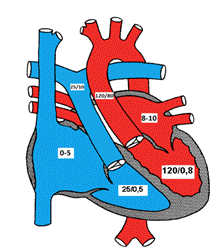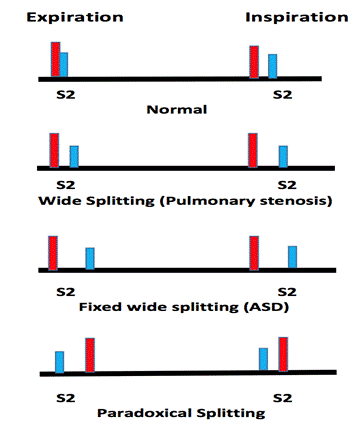Heart Sounds and Murmurs

The first heart sound (S1) represents closure of the atrioventricular (mitral and tricuspid) valves as the ventricular pressures exceed atrial pressures at the beginning of systole (point a). S1 is normally a single sound because mitral and tricuspid valve closure occurs almost simultaneously. Clinically S1 corresponds to the pulse.
The second heart sound (S2) represents closure of the semilunar (aortic and pulmonary) valves (point d). S2 is normally split because the aortic valve (A2) closes before the pulmonary valve (P2). The closing pressure (the diastolic arterial pressure) on the left is 80 mmHg as compared to only 10 mmHg on the right. This higher closing pressure leads to earlier closure of the aortic valve. In addition, the more muscular and stiff "less compliant" left ventricle (LV) empties earlier than the right ventricle. The venous return to the right ventricle (RV) increases during inspiration due to negative intrathoracic pressure and P2 is even more delayed, so it is normal for the split of the second heart sound to widen during inspiration and to narrow during expiration. Clinically, this is more remarkable with slow heart rates.
Abnormally wide splitting of S2 may occur in :
a) RV volume overload, such as atrial septal defect (ASD). In that case, the split is usually wide and fixed with no change difference between inspiration and expiration due to fixed RV volume (see ASD section).
b) RV outflow obstruction, such as pulmonary stenosis.
c) Delayed RV depolarization such as complete right bundle branch block.
Narrow splitting of S2 occurs in:
a) Pulmonary hypertension as the pulmonary valve closes earlier due to high pulmonary resistance.
b) Mild to moderate aortic stenosis as the A2 is delayed.
Single S2 may occur in:
a) If one of the semilunar valves is missing, as in pulmonary or aortic valve atresia and truncus arteriosus.
b) If both valves close simultaneously as in double outlet single ventricle or in large VSD with equal ventricular pressures
c) In pulmonary hypertension with equal right and left ventricular pressures.
Paradoxical splitting of S2 (P2 is heard before A2) occurs in:
a) Severe aortic stenosis
b) Left bundle branch block
In both conditions, the aortic valve (A2) closes after the pulmonary valve (P2). Since the respiration only affects P2, its effect in paradoxical splitting is the opposite of normal, i.e. inspiration causes narrow splitting while expiration causes wide splitting of S2
The third heart sound (S3) represents a transition from rapid to slow ventricular filling in early diastole. S3 may be heard in normal children.
The fourth heart sound (S4) is an abnormal late diastolic sound caused by forcible atrial contraction in the presence of decreased ventricular compliance.

|
|
|
|
:A2
|
:P2
|
|
A figure showing normal and abnormal splitting of the second heart sound |
|


